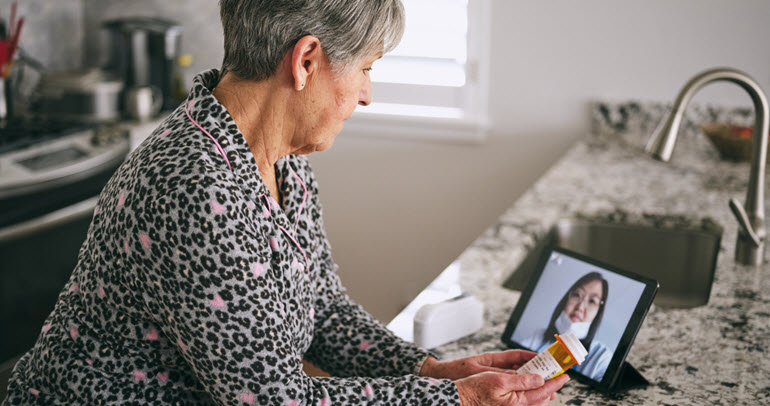
The COVID-19 virus is turbocharging the growth of telehealth. An adoption curve that long appeared challenging now hurtles toward more immediate, widespread implementation given the urgency to extend care to populations in need while maintaining social distance.
Telehealth (or E-health, telemedicine and related terms) allows for patients to access care in the privacy of their own home. While telehealth typically conjures an image of a patient and doctor chatting via web cams, telehealth encompasses much more. Many insurance companies’ and health systems’ telehealth platforms may include a patient portal, remote monitoring, appointment-making tools, a channel for secure sharing of patient information, etc.—an array of services that alleviates the need for face-to-face interaction. While telehealth services have existed for nearly two decades, now more than ever, keeping healthy individuals out of doctors’ offices and emergency rooms is crucial for flattening the COVID-19 infection curve and reducing an already enormous burden on healthcare providers. Telehealth is not just a nice-to-have alternative—it’s a necessity that could save lives.
But if you think telehealth will go out of vogue after the COVID-19 pandemic has calmed, think again. In the US, baby boomers compose roughly 16% of our population and this proportion is poised to double by 2060. Given that this population often lives in rural areas, expresses the most difficulty with appointment transport, and will likely need additional health resources as they age, telehealth is a fitting alternative. In fact, within the $2 trillion stimulus package from the US government, a good chunk is dedicated to expanding telehealth benefits for Medicare (the largest payer in the nation). When seniors get past the telehealth learning curve, you can bet they’ll adopt telehealth more widely. And this is true across various-aged audiences, including millennials, who already expect their healthcare delivery to be fast, efficient and convenient.
A number of companies with existing telehealth platforms are well-positioned to dominate in these times. Conversa, for example, enables patients to check their potential COVID-19 virus symptoms using chatbot technology. Beam Health’s telemedicine platform boasted a steady increase in providers signing on in just the past three weeks. While Beam accepts private payer insurance, most doctors who join set their own rates, bypassing insurance companies altogether. Even top investment blogs suggest that investing in telemedicine companies, such as Teladoc, is a sure bet for the short term and the long haul.
In sum: if your telehealth game isn’t currently on point, then you’re already behind.
I know how deeply my clients care about their patients and their members. Ensuring your telehealth services are in place, efficient, and most of all—familiarized—are valuable ways to act on your commitment to your patients and members. And because we at Escalent care about your patients and members, too, we want to help expedite the process. Below, I list five steps to guide your organization toward a successful strategy for implementing and/or refining existing telehealth services.
1. Conduct an internal audit.
First, you need a firm understanding of the telehealth services your organization offers and what gaps in telehealth care exist. Ensure you check all the major boxes for telehealth including (in this order) virtual visits (e.g., diagnoses), patient web portals and remote monitoring. Keep in mind this audit applies to not only types of telehealth services but also types of conditions, including mental health (which will be a tremendous need both during and in the aftermath of social distancing). Who are the key stakeholders who will need to sign off on building out key areas or creating new ones? Find those individuals (don’t forget the lawyers—does your state operate under the parity law, for instance?) and start prioritizing telehealth needs.
2. Assess awareness AND familiarity.
The philosopher George Berkeley once asked, “If a tree falls in the forest and no one is around to hear it, does it make a sound?” Are individuals even aware of the telehealth services you offer? Perhaps by now, COVID-19 has fueled general telehealth awareness, but familiarity is still lacking. Conduct quantitative research with your audience to understand its awareness around the services you offer, for what conditions, and specific levels of familiarity and use with those services. You must set expectations for patients/members—even during high-stress, high-stakes times. That means you have to get it right.
Perhaps equally important but often overlooked: providers’ familiarity with your telehealth system. Do healthcare providers know what is available to patients? And are providers comfortable using your tools? Typically, patients will seek information from a healthcare provider first—and that may include questions on telehealth. Ensure your provider teams are knowledgeable and ready to field these questions.
3. Identify barriers to telehealth use for your audience…in order to overcome them.
I’ll make this easy on you: The three chief barriers to using telehealth services (according to a LOT of peer-reviewed journal articles) are 1) a lack of self-efficacy in using the platform/tools, 2) fear that the care received will be less adequate than face-to-face care (e.g., “will my diagnosis be accurate?”) and 3) security/privacy issues. How do those barriers manifest for your organization’s specific audience and on your specific platforms? That’s where research comes in, again. Once you’ve addressed and dug into those specifics, you can answer an even more important question: What do your members or patients need from you in order to “move the needle” on utilization? Additional training over the phone? A free trial visit? Some other incentive? Qualitative insights can really deliver here, allowing you to go deep into understanding the higher-level emotions driving these barriers.
4. Conduct usability research along the telehealth journey.
With your findings from step 3, you can implement learnings and improve your telehealth programming and platforms. Now for the ultimate test: did your improvements work? Clearly, it’s a waste of time and effort to build a telehealth program, only to flop on its implementation. Understand the telehealth journey as your users understand it. Where are the entry gates to telehealth? What are the pain points once on the platform? Do providers express similar challenges in usability or are their issues unique? Can your platform withstand the inevitable volume of patients who will use your tools? What are the individuals’ likely next steps after a telehealth visit? It will be tempting to gather information on the negative for course-correction, but don’t neglect the opportunity to garner feedback about the advantages and benefits of your telehealth services. Hang on to these nuggets: you’ll want to communicate those later in your…
5. Message testing.
You know your audience members’ specific barriers. You know the benefits they cite. You now also know more about when and from what channels they’re gathering their information on your telehealth services. So now it’s time to make sure these elements align by testing messages across channels. Do you have the budget and the ability to do target marketing? Even better. And keep in mind, if telehealth services grow as much as we expect them to, these messages should be tested among both existing patient/member markets as well as prospective customers, and should include materials targeting each (don’t forget SEO).
Above all, my biggest piece of advice: Act fast (I did say you may already be behind). If you have immediate access to a consumer panel or an internal survey tool, now is the time to assess your telehealth strategy and audience familiarity. Consumers will appreciate your urgency and desire to improve health outcomes quickly and will be happy to provide their feedback—according to our own internal research, consumer response rates actually increased over the last few weeks now that most consumers are home with little to do. If you don’t have self-service tools, or could use a hand with them, we can help. There is no one-size-fits-all research study for telehealth implementation and success—and there shouldn’t be. Our team of experts can jump in to your organization’s telehealth journey at the precise point you need and can deliver results quickly. And, rest assured, we know telehealth and the questions you need to be asking right now.
COVID-19 has caused more damage in the last three months than many of us will ever see again in our lifetimes. Effective telehealth services could play a major role in nursing our nation back to health, both in the short term and well after this situation concludes. But effective telehealth services mean nothing if they go unused or they fail to deliver on what’s promised. We’re here to position you to better service patients and members faster and more effectively.
Interested in hearing more of our perspective or learning what this means for your business? Send us a note and lets chat.









